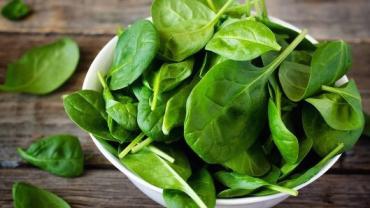
It isn’t often that cartoon characters dispense accurate nutritional advice. But there’s something to be said for Popeye singing the praises of spinach. Spinach is available year-round fresh or frozen and is quite versatile; it fits nicely into several disparate dietary approaches: vegan vegetarian omnivorous low-carb and ketogenic. It’s great in omelets can be used raw in salads baked into lasagna sautéed with garlic and olive oil or made into creamed spinach with generous helpings of cheese and cream for a low-carb high-fat dish. It may be slightly bitter but overall its flavor is milder than that of hardier greens such as kale mustard and collards.
Like other leafy greens spinach is loaded with nutrients. Per 100-gram serving its vitamin K content is off the charts at over 600% of the daily value (DV). It provides nearly 50% of the DV for folate 47% of the DV for vitamin C and close to 200% of the DV for vitamin A (as carotenoid precursors). It’s no slouch in minerals either. 100 grams of spinach provides 20% of the DV for magnesium 45% for manganese 16% for potassium and 15% for iron. With 10% of the DV for calcium a generous serving of spinach shows why dark leafy greens are an important source of calcium for those with intolerance to dairy. With just 4g of carbohydrate—2g of which are fiber—spinach is about as low-carb as it gets. Its glycemic load is practically negligible making spinach a good food to fill up on without affecting blood sugar or racking up calories. Providing just 3 grams of protein though we can assume that Popeye didn’t rely on spinach to build and maintain his muscles!
Organically grown spinach may have a higher concentration of vitamin C and flavonoids than conventionally grown and may have a lower nitrate content. However the lower nitrate content is not necessarily something to celebrate. High-nitrate vegetables such as parsley beets and celery are known to exert beneficial physiological effects particularly for individuals with hypertension or cardiovascular disease. A serving of spinach that provided 845mg/day of nitrate was shown to reduce systolic and diastolic blood pressure in healthy adults; the effect may be even greater for those with hypertension.
It would be irresponsible to sing the praises of spinach without also acknowledging a potential downside. Spinach contains oxalic acid which may interfere with the absorption of some of its minerals. However the body may adjust for reduced bioavailability by increasing absorption and the effect of anti-nutrient compounds in foods may be a lesser factor when the overall mineral content of the diet is high and unrefined cereal grain consumption is low. Rat studies suggest that even though oxalic acid remains in spinach after cooking it doesn’t interfere with magnesium absorption—at least in rats that were magnesium deficient. (This is still noteworthy however considering the number of people who may be magnesium deficient.) Oxalate content does not seem to vary between organic and conventionally grown spinach.
Spinach doesn’t just shine at mealtime. It’s a good source of antioxidants and some of the individual components of spinach such as a glucurinated flavonoid have demonstrated greater free radical scavenging capacity in cultured fibroblasts than the well-known antioxidants EGCg (found in green tea) vitamin E and N-acetylcysteine. Spinach extracts have been explored for their potential anti-cancer properties owing largely to their antioxidant function and lack of observed toxicity or adverse side-effects.
The carotenoid content of spinach may be protective for eye health and vision. Epidemiological data from the famous Nurses’ Health Study indicates that higher intakes of foods rich in lutein and zeaxanthin—such as spinach—had decreased risk of developing cataracts. These carotenoids may also help protect against macular degeneration.
Consuming more spinach is an excellent natural way for patients to increase their nutrient intake regardless of what type of diet they follow. For the Paleo and low-carb folks simply sautéing spinach is divine while people who prefer something a little sweeter can add spinach to a fruit and vegetable smoothie with some blueberries or sliced apple.